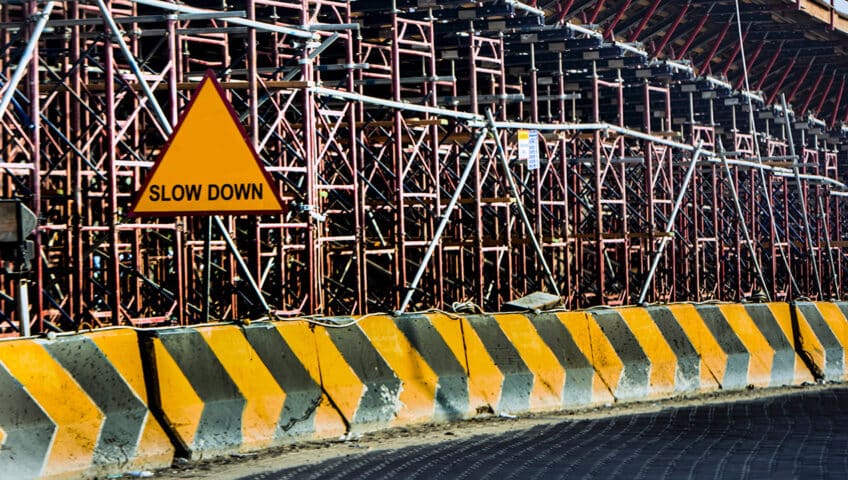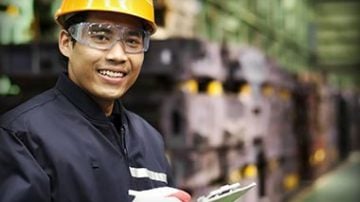Prioritizing Jobsite Safety
Safety violations in the construction industry are fairly common and one hundred percent preventable. A safety violation refers to the violation of a workplace safety standard, regulation, policy, or rule. They can include both the violation of safety policies created by an individual workplace and violations of that industry’s regulatory standards. Knowing some of the most common safety violations can help you plan ahead to prevent them.
1. Lack of Proper Fall Protection
Falls at construction sites are responsible for numerous injuries and deaths. The US Department of Labor (DOL) lists falls as one of the leading causes of traumatic occupational death, accounting for eight percent of all occupational fatalities from trauma.
Construction workplace safety regulations dictate that any time a worker is at a height of six feet or more, the worker is at risk of a fall injury and requires protection.
2. Lack of Head Protection
In addition to falls, “struck by” incidents are also responsible for numerous injuries and deaths. “Struck by” can refer to workers being hit by machinery or falling materials and equipment. The proper PPE, including head protection equipment can prevent many of these “struck by” hazards.
Construction workplace safety regulations require all employees working in areas where there is a possible danger of head injury from impact, or from falling or flying objects, or from electrical shock and burns, to wear protective helmets.
3. Lack of Respiratory Protection
Every construction site poses respiratory risks. Construction site air is often filled with fumes, dust, vapors, smokes, gasses, sprays and other materials that are hazardous to breathe. These hazards may cause cancer, lung impairment, other diseases or death.
Construction workplace safety regulations require construction employers to provide respirators that are adequate in protecting them from air-borne dangers.
4. Insufficient Hazard Communication
Construction project teams should be made aware of all materials, substances and their related hazards on a jobsite before any work begins.Contractors should ensure that their related hazards are documented and shared with the rest of the project team.
Construction workplace safety regulations require hazard communications to include standard labeling, data sheets and employee training where relevant.
5. Improperly Constructed Scaffolding
Scaffolding is a necessary aspect of almost every construction project. If scaffolding is not built and kept up with properly, it can create its own set of hazards and risks for construction workers.
Scaffold accidents most often occur as a result from planking or support giving way, or from a team member slipping or being struck by a falling object.
Construction workplace safety regulations require employers to provide qualified training to each employee who performs work while on a scaffold. The training must enable employees to recognize the hazards associated with the type of scaffold being used and to understand the procedures to control or minimize those hazards.
6. Not Enforcing Lockout/Tagout
Lockout/ Tagout refers to specific practices and procedures that safeguard employees from the unexpected startup of machinery & equipment, or the release of hazardous energy during service or maintenance activities. Locking out machines before servicing them or providing maintenance to them helps ensure their safety and the safety of those around them.
Construction workplace safety regulations dictate that employers must establish procedures for safely removing the energy source from machines and attaching appropriate devices on them to prevent unexpected startup or re-energization. Employers must also establish a safety procedure that addresses any stored energy the machine may have.
7. Powered Industrial Trucks
Powered industrial trucks (PIT) also called forklifts or lift trucks, are involved in thousands of construction site injuries every year. Injury occurs typically when lift trucks are inadvertently driven off loading docks, lifts fall between docks and an unsecured trailer, they strike a construction site worker, or when they fall while on elevated pallets and tines.
Construction workplace safety regulations vary depending on the type of PIT being used and the unique construction site environment. It is the contractor's responsibility to ensure their team has the proper training and safety equipment needed to perform their job with the PITs safely.
8. Lack of Employee Training
If your team does not have the proper knowledge to perform their specific job or task, they pose a risk to themselves and others around them. Every member of your construction team should be properly trained not only on their job duties but also on all safety protocols that relate to the jobsite. One of the biggest training gaps is in proper implementation of fall protection strategies.
Construction workplace safety regulations dictate employers must confirm in writing that a worker has completed the necessary preparation or retrain the employee.
9. Lack of Eye and Face Protection
Eye protection is a must during any construction work. Dust, dirt, metal or wood chips from chipping, grinding, sawing, hammering, or using power tools can easily damage your eyes. Chemical substances, hot liquids and other hazardous solutions also pose a health risk to your eyes.
Construction workplace safety regulations require employers to ensure each affected employee uses appropriate eye or face protection when exposed to eye or face hazards from flying particles, molten metal, liquid chemicals, acids or caustic liquids, chemical gasses or vapors, or potentially injurious light radiation.
10. Inadequate Machine Guarding
Machines must be safeguarded for the operator as well as any other construction workers in the vicinity. This includes any part, function or process of the machine. Hazards from operating any construction machinery must be eliminated or controlled.
Construction workplace safety regulations dictate that machine guards be affixed to the machine where possible and secured elsewhere if for any reason attachment to the machine is not possible.
Prevent Construction Safety Violations
Safety violations are best prevented through detailed safety programs for the construction industry and frequent safety training. These two items help to grow and nurture a safety culture within your company that ensures your team makes safety their top priority. This includes following guidelines and standards set in your safety programs that keep your job sites free of hazards and your workers alert and aware. There are also several other precautions and preventative measures you can take to make your construction site safer. Learn more about these workplace safety tips by reading 10 Tips for a Safer Construction Worksite.
As dedicated safety compliance consultants, Industrial Compliance & Safety works with you and your company to create and maintain safety programs and training that help your business remain within construction safety regulations. Prevent violations, fines and unnecessary injuries with a proactive safety plan approach. Learn more about how Industrial Compliance & Safety can help you with your construction safety protocols.
Ready To Get Compliant Today?
Call us or complete the form below!





